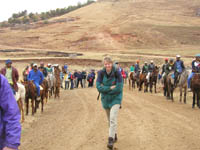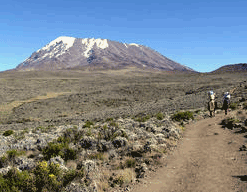About Us
The draft IUCN Programme 2013-2016: Nature+ Draft for consultation, May 2011.
The draft IUCN Programme is undergoing a major consultation programme. Comments and amendments on this draft Programme can be sent to programme@iucn.org no later than 10 October 2011.
More Information about our Network and what we do
Our Annual Reports on activities and accomplishments
Our Strategic Plans:
-
2009-2012 WCPA Mountains Biome & Connectivity Strategic Plan
-
2005-2008 WCPA Mountain Biome Strategic Plan

Our Mountains Biome Network draws on the strength of approximately 250 actively engaged volunteer members around the world. They represent leading conservation NGOs (non-governmental organizations), universities, governments, agencies, smaller non-profit organizations, and stakeholder groups such as recreationists, indigenous peoples, women's groups, youth groups, and
others concerned with preserving and protecting the world's precious natural and cultural resources in mountain regions.
FAQs - Frequently asked questions and other information
What is the value of the Mountain PA Network?

Network members constantly communica te, collaborate, and leverage their comraderie and expertise to protect the precious natural and cultural resources of mountain regions around the world, like magnificent and wild Makalu (8463m) shown here, located in the Makalu - Barun National Park and Conservation Area of Nepal. They develop and share new ideas and techniques, attend and speak at conferences, and advocate for mountain protection to land managers, agencies, governments, and mountain stakeholder groups, including those who may live near mountains or in distant metro areas that depend on the mountains for their fresh water. Read a testimonial letter about the value of our work.
What is a "mountain protected area"?
Mountain protected areas are parks, wilderness and wild land areas, reserves, refuges, world heritage sites, and other mountain areas granted protection status in various ways around the world. One example of a mountain PA is Mount Kilimanjaro National Park in Kenya (shown below). It is protected as both a Kenyan national park and as a UNESCO World Heritage Site.
How do you define "mountains"?
Mountains are defined (operational definition) as being conspicuous, steep features having altitudinal plant zonation, and at least 300 metres in relative relief. Mountains are found on every continent on Earth, and on many oceanic islands.
Why are mountains so important to Mankind's future?
Mountains are the origin home of the 5 most important food staples of the world.
Mountains are refuges of great biological diversity and high levels of endemism, they are critical as water towers and catchments for almost all of our major rivers providing water to at least half of humanity. They are often the last sanctuaries for endangered cultures and endangered wild plants and animals.
As a single great landscape type, reaching almost from pole to pole, mountains encompass the most extensive array of topographic, soils, climatic, faunal, floral and cultural differentiation known to mankind.
The conspicuous beauty and awesomeness of mountains, and their seeming immutability have made them sacred to the major religions of the world, and often the abode of ancestors. Many are magnets attracting alpinists, hikers, artists and tourists. This helps to explain why 32% of the world’s protected areas are found in mountains.
The 2003 United Nations Protected Areas list gives a total of 9,345 mountain protected areas covering 1,735,828,000 hectares. Many regions with mountains have no representative protected areas such as the Atlas Mountains, Antarctica, Papua New Guinea and the Middle East.
For high mountains, 61 World Heritage areas have been designated, and 28 additional sites have been recognised to fill gaps.


